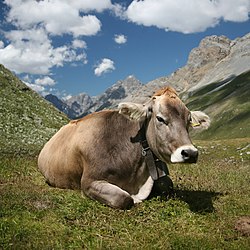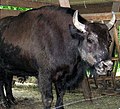"Cow" redirects here. For other uses, see Cow (disambiguation).
For other uses, see Cattle (disambiguation).
Cattle—colloquially cows[note 1]—are the most common type of largedomesticated ungulates. They are a prominent modern member of thesubfamily Bovinae, are the most widespread species of the genus Bos, and are most commonly classified collectively as Bos taurus. Cattle are raised as livestock for meat (beef andveal), as dairy animals for milk and otherdairy products, and as draft animals (oxen or bullocks that pull carts, plowsand other implements). Other products include leather and dung for manure orfuel. In some regions, such as parts of India, cattle have significant religious meaning. From as few as 80 progenitors domesticated in southeast Turkey about 10,500 years ago,[1] according to an estimate from 2011, there are 1.4 billion cattle in the world.[2] In 2009, cattle became one of the first livestock animals to have a fully mappedgenome.[3] Some consider cattle the oldest form of wealth, and cattle raidingconsequently one of the earliest forms of theft.
Taxonomy
Cattle were originally identified as three separate species: Bos taurus, theEuropean or "taurine" cattle (including similar types from Africa and Asia); Bos indicus, the zebu; and the extinct Bos primigenius, the aurochs. The aurochs is ancestral to both zebu and taurine cattle.[citation needed] Now, these have been reclassified as one species, Bos taurus, with three subspecies: Bos taurus primigenius, Bos taurus indicus, and Bos taurus taurus.[4][5]
Complicating the matter is the ability of cattle to interbreed with other closely related species. Hybrid individuals and even breeds exist, not only between taurine cattle and zebu (such as thesanga cattle, Bos taurus africanus), but also between one or both of these and some other members of the genusBos – yaks (the dzo or yattle[6]),banteng, and gaur. Hybrids such as thebeefalo breed can even occur between taurine cattle and either species ofbison, leading some authors to consider them part of the genus Bos, as well.[7]The hybrid origin of some types may not be obvious – for example, genetic testing of the Dwarf Lulu breed, the only taurine-type cattle in Nepal, found them to be a mix of taurine cattle, zebu, and yak.[8] However, cattle cannot successfully be hybridized with more distantly related bovines such as water buffalo or African buffalo.
The aurochs originally ranged throughout Europe, North Africa, and much of Asia. In historical times, its range became restricted to Europe, and the last known individual died inMasovia, Poland, in about 1627.[9]Breeders have attempted to recreate cattle of similar appearance to aurochs by crossing traditional types of domesticated cattle, creating the Heck cattle breed.
Etymology
Cattle did not originate as the term for bovine animals. It was borrowed fromAnglo-Norman catel, itself from medieval Latin capitale 'principal sum of money, capital', itself derived in turn from Latin caput 'head'. Cattle originally meant movable personal property, especially livestock of any kind, as opposed to real property (the land, which also included wild or small free-roaming animals such as chickens — they were sold as part of the land).[10]The word is a variant of chattel (a unit of personal property) and closely related tocapital in the economic sense.[11] The term replaced earlier Old English feoh'cattle, property', which survives today asfee (cf. German: Vieh, Dutch: vee, Gothic:faihu).
The word "cow" came via Anglo-Saxoncū (plural cȳ), from Common Indo-European gʷōus (genitive gʷowés) = "a bovine animal", compare Persian gâv,Sanskrit go-, Welsh buwch.[12] The pluralcȳ became ki or kie in Middle English, and an additional plural ending was often added, giving kine, kien, but alsokies, kuin and others. This is the origin of the now archaic English plural, "kine". The Scots language singular is coo orcou, and the plural is "kye".
In older English sources such as theKing James Version of the Bible, "cattle" refers to livestock, as opposed to "deer" which refers to wildlife. "Wild cattle" may refer to feral cattle or to undomesticated species of the genus Bos. Today, when used without any other qualifier, the modern meaning of "cattle" is usually restricted to domesticated bovines




No comments:
Post a Comment